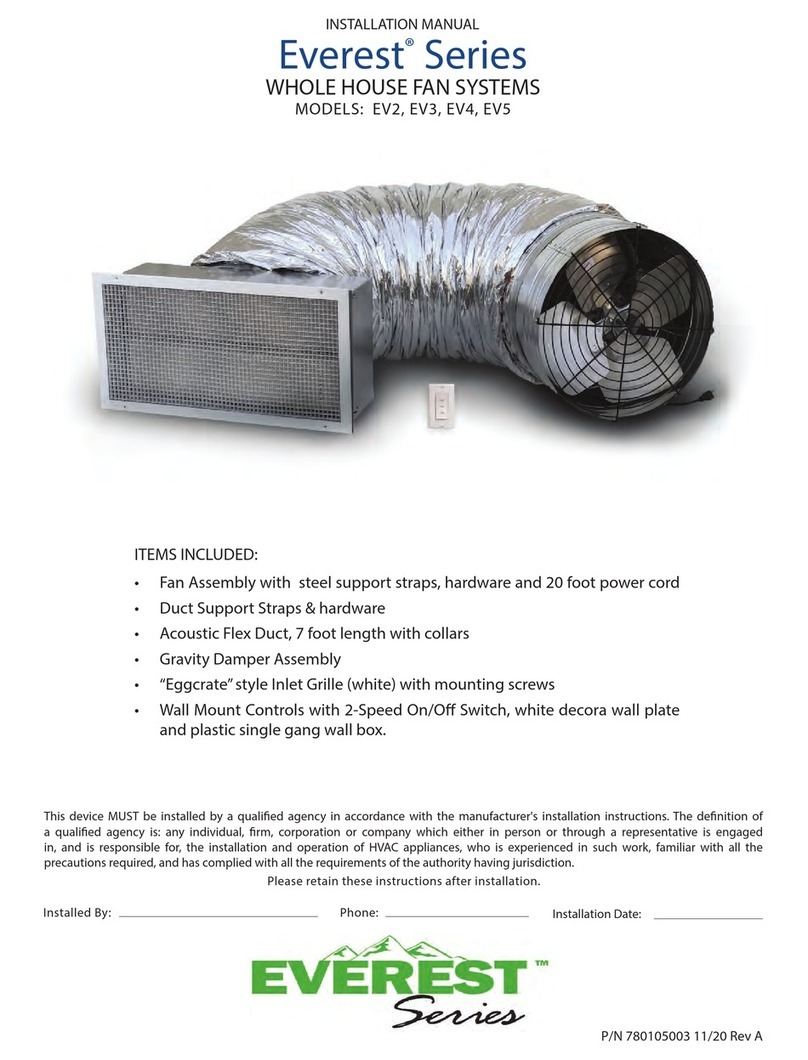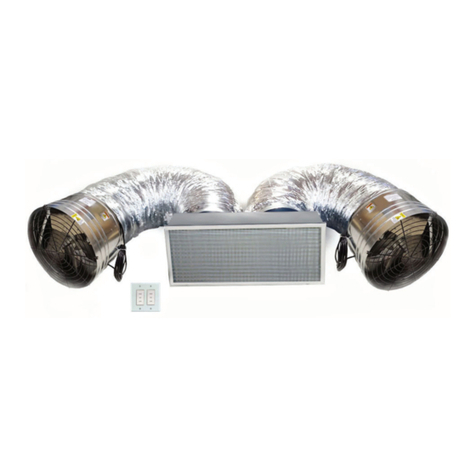
page 7 of 16
The ideal orientation of unit’s gravity damper is in a level position. If necessary, however, the damper can be in-
stalled at a slight angle. TIP: before beginning the installation, make sure that the fan assembly is undamaged,
and that the fan blade rotates freely. Brace or clamp the fan assembly to a secure object, and temporarily plug
in the fan’s power cord into a grounded power outlet to verify smooth and correct operation.
Be aware that the fan is quite powerful and will draw in loose objects or de
Be aware that the fan is quite powerful and will draw in loose objects or de
bris, and will blow dirt,
bris, and will blow dirt,
debris and other objects with force!
debris and other objects with force!
Use eye protection when operating the fan to avoid injury from blowing sand or debris! Keep hands
Use eye protection when operating the fan to avoid injury from blowing sand or debris! Keep hands
and other objects away from the rotating fan blade!
and other objects away from the rotating fan blade!
TIP: Before beginning the installation, verify that the damper assembly is undamaged, and that the damper
doors operate freely, opening and closing fully without binding or restriction.
INSTALLATION: GRAVITY DAMPER
GRAVITY DAMPER ORIENTATION NOTE
1. From consideration of the principles of whole-house
fan operation, determine the best general area for
installation of the gravity damper assembly. The
damper assembly is to be mounted in the attic with
its bottom edge opening into and ush with the
ceiling of the living space. The eggcrate inlet grille
is to be mounted on the ceiling of the living space,
covering and engaging with the opening of the
damper assembly.
2. Using the cardboard from the fan system’s packaging,
or other suitable material, make a rectangular tem-
plate for the rough opening of the damper assembly
to these dimensions making sure all sides are at right
angles to each other):
a. Cascade CA 6.5 model: 14-1/4” wide, 36-1/4” long FIGURE 1 - TEMPLATE
3. Take the template into the attic, above the general area for installation, and determine the exact desired
location for the rough opening for installation of the damper assembly. There must be at least 36” of
vertical clearance above the damper assembly location, and the damper assembly must be fastened to
secure framing (ceiling joist, roof truss, or additional framing) along at least one long side or both short
sides of the damper assembly! Add additional framing as required to support the weight of the damper
assembly and duct.
a. For existing construction, the anges surrounding the opening of the damper assembly may
be removed for clearance (as with 16” on-center framing) and/or to allow the side or sides of
the damper assembly to make direct contact with the framing used to support the damper
assembly. Leave anges in place if they will not be fastened to framing, if possible. Additional framing
may be added after the damper assembly is placed into the rough opening, so the anges can
remain in place if space allows.
b. For new construction, before the ceiling drywall is hung, frame in a rough opening for
installation of the damper assembly from below. Leave the assembly anges in place and
simply attach the damper assembly to the bottom of the framing using appropriate
fasteners installed through the anges. Skip all following steps regarding cutting the rough
opening into the ceiling and proceed with installation of the duct and fan assembly.
P/N 780105002 01/21 Rev A





























